Genre: Education/Compilation Developer: Novotrade Publisher: Sega Ent. Players: 1 Released: 1994
The Ecco series seems as endless as the vast ocean, with always something more to discover and review. And I want to see everything related to this amazing series, so I dived into Ecco’s only appearance on a relatively unknown console, during the Genesis’ lifetime: Ecco Jr. made a quiet splash on the Pico, an obscure, oddball console released by Sega in 1994, and marketed as educational for young children. Sega fans were currently excited about games like Sonic 3, Streets of Rage 3, and (more in the background) Ecco: The Tides of Time; while Nintendo fans were hyped about games like Donkey Kong Country and Super Metroid. So in that context, it wasn’t at all exciting for there to be a weird new console aimed at helping little kids learn to read or count, and the Pico flew under the radar completely. I bet that most people don’t even remember that the console existed!
The main gimmick of the Pico is the form (and format) of the console itself: A plastic clamshell that resembles a laptop computer, in a time when practically no one owned even a desktop computer yet. Opening the plastic case and comparing it to an actual laptop: The would-be keyboard-area is a yellow pad for using the attached stylus-pen, with a few buttons on the left side: Four buttons arranged like a D-pad, plus one giant red action-button. The would-be screen area holds the ridiculous “Storyware,” which is a combination storybook-plus-video game cartridge (the cartridge part plugs into the console, on the bottom of the book). Despite the console being obviously designed like a laptop, there’s no screen, and it sends its image-out to the TV.
The console is quite a jumble of different elements: Books, electronic stylus-pen-and-pad, video games on TV; however, there’s one more unique aspect in that jumble: The storybook pages also contain sensors, so the stylus pen not only interacts with the stylus-pad, it can also click on the drawings on the pages! Theoretically, this would allow for very involved, complex gameplay experiences.
If not for Ecco Jr., I probably never would have looked at the Pico, and I can’t recommend anyone actually hunt down and purchase a console that was basically meant for toddlers… except maybe parents with toddlers. And even in that case, the Pico will still seem like outdated technology, lacking in much charm or appeal. The stylus pen and pad really wasn’t very exciting in the first place. And the idea that electronic, thick-paper storybooks could ever seem high-tech, is clearly an idea from a bygone era!
Ironically, it’s the Pico’s embrace of its current technologies, which ends up defining the console by its limitations, more than anything. The laptop theme is cheap and gimmicky, for a world that was excited about computers, but could not afford to buy them yet. So, the Pico’s design just emphasizes how much it’s not the real item that people actually wanted! I understand how it might have still seemed appealing, especially for young kids, as a bright-plastic fake laptop, but unfortunately, that theme makes it seem sorely inadequate, for lacking a screen, keyboard, etc.
It’s interesting what a short, specific time-period the Pico actually represents: those years when computers were new and exciting but still too expensive for most people to afford or have much access to. The Pico’s lack of screen also places it back to when screens and monitors were considered expensive products and too cost-prohibitive to be included here. Apparently, someone thought that stylus pens and-pads were exciting in 1994, but if it had been a couple or few years later, I wonder if the stylus might have seemed less advanced (and less desirable) than a mouse! And that ’90s trend of electronic drawing products really came directly from the new appeal and mystique of computers, with MS Paint. So, that meant that art video games were only relevant for the remaining years before computers actually became affordable and commonplace. Once everyone had access to computers with programs like MS Paint, it didn’t seem so exciting anymore.
If nothing else, the Pico was ambitious with its limited technologies that it was combining; however, I had really low expectations for the console, and I thought there was something fundamentally wrong with the concept of video games that make us look away from the TV, to look at books! I couldn’t imagine the gameplay being immersive, and I couldn’t imagine how all these disparate elements could really make sense together.
Since I don’t own a Pico, nor do I plan on buying one, I’m checking out Ecco Jr. via emulation. It’s a unique experience, even without the physical console. On the computer screen, the emulator (PicoDrive) displays three separate windows: one for the TV image, a second window for scans of the book pages, and the third window is a photo of the yellow stylus-pad (with our mouse-arrow substituting for the stylus-pen). I got it all from Caverns of Hope, Ecco’s best fan website, covering the entire series, including Ecco Jr. on Pico, with download links for its ROM and emulator (Click here to check it out!) .
After downloading, we need to manually place the book scans from the ROM package into a folder of the emulator, otherwise the ROM will play but without the book-scans. As I copy-pasted those images, it was somewhat surprising to see that there was only a cover, plus five scans of open pages, meaning there are 10 pages total, but the book opens to five different scenes. I’m not sure how many pages I would really want in a book video game, but a picture book that opens up to five scenes, is not a big book!
Ecco Jr.’s title-screen actually looks and sounds great, with music that’s dark and atmospheric, similar to the Genesis soundtracks of Ecco and Tides of Time. It lacks the cheerfulness of Genesis Ecco Jr., which was more what I had been expecting. The music sounds dark but also relaxing.
We start by turning the page at the title-screen, which means using our PC’s mouse-arrow to select that choice, in the emulator’s menu (at top of the game window). A new song starts for the first scene, a seabed with Big Blue hanging out with us. And for the first time, I finally understood how the console works. The TV shows the same image as the book, but built of pixels, and with slight animations, like the fish are drifting back-and-forth, the clam opens and shuts, and Big Blue moves slightly, as bubbles float up from his breath. I’m surprised to say that the overall effect is very cool. Ecco is well-animated, and we can even see the little stars on his forehead. Sometimes he swims around by himself, in a little circle, creating bubbles by his movements. His sonar has a cute, high-pitched sound.
It took me a little while to realize what the graphics remind me of: those computer games that I would sometimes see, as a kid in the ’80s. Games with graphics that were simplistic but also very detailed, especially those point-and-click games in which we trigger animations, by clicking on different details.
It’s hard to pinpoint why the graphics look strange, though. The pixels seem big, like an 8-bit console. Ecco and the other creatures are large, detailed sprites built of those large pixels, so I guess that’s why it looks so odd. At some point, I was surprised to read that the Pico console was based on the Genesis! Judging only from this title, its graphics seem more limited, and I never would have thought they were related consoles.
The controls feel nothing like an Ecco game because his movements onscreen just correspond with our movement of the stylus/mouse-arrow over the stylus pad. Clicking the mouse corresponds with the stylus pressing down on one spot, and it makes Ecco send out his sonar. Sending sonar at the fish brings us to a new fading blue background, with fish to gather/count. It turns out to be surprisingly difficult. We have to click at the moment that the fish swims by Ecco’s mouth. 10 fish later, we’re back to the main scene.
Big Blue is not feeling talkative, but clicking on the giant oyster will make it show us how it can count to 10 pearls. Clicking on the larger fish leads to a shapes-sorting game. It’s vaguely educational, because it shows words for the matches we make, like “big triangle,” or “small oval.” We can even match colors for the screen to display “blue” or “green,” etc. In a mid-’90s household with no computer, this might have seemed like a nice way for a small kid to learn a few words to read and write. The mini-game doesn’t end until we click on the page of the storybook, to exit back to the main scene.
When we turn pages, Ecco swims across the screen, before the next scene appears (the emulator calls the second scene “Page two,” although each scene is made of two book-pages). The lobster offers us a better shape-matching game, choosing stone pieces to match the shape of a hole. The tiny crabs let us stack them into piles, with the screen showing the math of it, like “3+1=4.” This game also seems to end only when we click on the paper page. In the background, piles of stone carvings of numbers, seem to do nothing but light up on TV, when Ecco sonar scans them. And the row of five red shells release crabs according to their number in the row (so the third shell sends out three crabs, and so on). Page three has a teeter-totter, so we balance each side with creatures that have dots on them, like dice. After balancing 12 dots on each side, nothing happens; it’s another game that only ends by page-clicking.
An odd game, with a 2D side-view, has Ecco using sonar to push a blowfish around to collect bubbles, so the blowfish gets bigger and bigger. We have to avoid jellyfish and sharks, so this is the closest resemblance to a normal Ecco title. There’s also a nice memory-matching game, with creatures hiding in the rocks.
Page four features hand-drawn crystal-Glyphs, and they bring up a basic music program, which is easily the most impressive thing so far! Musical notes are crystals, each one showing the text of what note it is (“do,” “re,” “mi,” etc.). The crystals’ color changes for each note. There are pre-loaded song segments, which will display in crystals, along with the title (like the first notes of “Mary Had a Little Lamb”). The coolest part is that we can modify the notes of these songs, and then play them, or we can make up our own songs by placing crystals against the blank background. As a kid, I never got into music very much, and I’ve wondered what would have possibly gotten me more interested in music? Maybe a music-video game like this, would have done the trick!
Page four also has a jellyfish-game of lining up numbers 1-10 in their proper order, but this is boring and pointless. And there’s a game of guiding a crab through a maze, except it’s not really a maze, and the crab always walks in the direction that he should. Ecco only uses sonar to prompt him to walk. Strangely, clams get in the way of the crab, and they will send him backwards, unless Ecco’s sprite is on top of the shells, clicking the stylus/mouse to keep the shells from opening-up. It’s strange but it’s another game that’s nice for resembling a more traditional-style video game.
Page five shows a cut scene of Ecco making an underwater pinwheel and giving it to Big Blue, with text congratulating us for finding all the treasures from the previous scenes. It doesn’t depend on actually completing all the games though. It seems to really just be checking if we tried all the games or something like that.
Finally, we have the most valuable mini-game: A drawing-program, which was still something novel in 1994. The world was still excited about Mario Paint, which was released two years earlier, so Ecco Jr.’s art-program would have seemed great. We have all the standard functions: We can draw with lines of different width and color; we can place lines between two points; we can fill in colors with the paint bucket (including rainbow paint, which is ridiculous and fun). We can also choose from a TV screen of stamps, like different fish, a starfish, a dolphin, a crystal, etc. The smaller images are just sprites to place around the screen, while the big images are drawings which the CPU quickly draws and colors in while we watch. The background is the same as the first stage, but we can choose to draw over any background from the game, or we can draw on screens of solid colors. The UK box of Ecco Jr. promises “animation,” but this only refers to being able to place some sprites that are slightly-animated.
This art-program also uses input that’s more advanced than the rest of the title. Everything else uses only the stylus-pad for gameplay input, while clicking on the book can be used to enter or exit the various mini-games. The art-program has the extra gimmick of the pages themselves interacting with the game, as we have a full selection of art tools drawn onto both pages, for us to click on those drawings (to choose color, art tool, stamps, etc.). The drawing of the seashell lets us switch among the three songs. It’s nice to see that the Pico is capable of more complex input and gameplay like this!
If the Ecco main series offers an ocean of gameplay experiences, then Ecco Jr. on Pico is like a small kiddie pool of gameplay experiences. Five picture-book scenes containing mini-games, the highlights being the music and art programs. It’s more than I expected to see here, in an electronic storybook-with-stylus-plus-TV output. While the music-program is very basic, it gets credit for such a cool theme, using crystals as notes. Also, the art-program seems pretty advanced. It’s not quite on-par with Mario Paint, but it’s definitely more interesting than MS Paint of the time, and the ocean is a cool theme for the backgrounds and stamps.
Ecco Jr. must be one of the best titles released for the short-lived Pico… which was actually only short-lived in America and Europe, with its whole life only spanning four years,1994-1998. But apparently, it never died in Japan, and it was upgraded as the Advanced Pico Beena in 2005, which is still going today! Even more incredible is that the upgraded console keeps the same basic design, so there’s still no screen, or anything else that might have seemed obvious to add to it!
I can’t recommend anyone track down such a niche console, only aimed at small kids. I can, however, recommend that Ecco fans swim through this title via emulator. The rarity of the Pico means that the original hardware just isn’t available for most people, and I’ve never seen the console in real life!
Buying one online is also cost-prohibitive, with the Pico currently selling for about $80, just because it’s rare (compared to the Genesis selling for about $20, because it’s common and available everywhere). So, Ecco Jr. gets my recommendation to download it from Caverns of Hope.
Ecco Jr.’s soundtrack is pretty consistent with the main series on Genesis, so the music is enough of a reason to give this title a swim-through. Plus, it’s interesting to see Ecco’s unique, beautiful gameplay attempted to morph into an educational title, plus a music- and art-maker, for an obscure, gimmicky, doomed console. Check it out for a few more relaxing songs, and some of the Ecco series’ last few scraps of unique graphics and gameplay to be found washing ashore.
Rating (out of 5): 




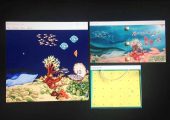
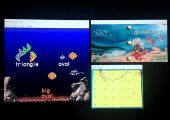
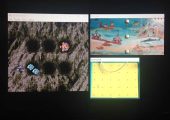
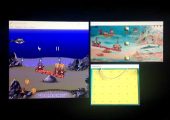
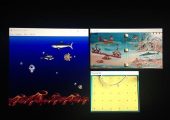
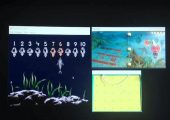
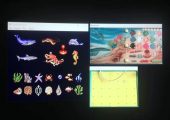
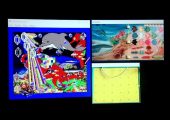
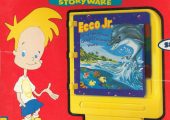
Recent Comments